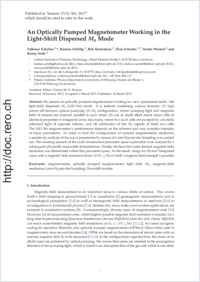An optically pumped magnetometer working in the light-shift dispersed Mz mode
- Schultze, Volkmar Leibniz Institute of Photonic Technology, Jena, Germany
- Schillig, Bastian Leibniz Institute of Photonic Technology, Jena, Germany
- IJsselsteijn, Rob Supracon AG, Jena, Germany
- Scholtes, Theo Leibniz Institute of Photonic Technology, Jena, Germany - Physics Department, University of Fribourg, Switzerland
- Woetzel, Stefan Leibniz Institute of Photonic Technology, Jena, Germany
- Stolz, Ronny Leibniz Institute of Photonic Technology, Jena, Germany
-
10.03.2017
Published in:
- Sensors. - 2017, vol. 17, no. 3, p. 561
magnetometer
optically pumped magnetometer
light shift
Mz
magnetic-field resolution
Latin Hypercube Sampling
Downhill simplex
English
We present an optically pumped magnetometer working in a new operational mode— the light-shift dispersed Mz (LSD-Mz) mode. It is realized combining various features; (1) high power off-resonant optical pumping; (2) Mz configuration, where pumping light and magnetic field of interest are oriented parallel to each other; (3) use of small alkali metal vapor cells of identical properties in integrated array structures, where two such cells are pumped by circularly polarized light of opposite helicity; and (4) subtraction of the Mz signals of these two cells. The LSD-Mz magnetometer’s performance depends on the inherent and very complex interplay of input parameters. In order to find the configuration of optimal magnetometer resolution, a sensitivity analysis of the input parameters by means of Latin Hypercube Sampling was carried out. The resulting datasets of the multi-dimensional parameter space exploration were assessed by a subsequent physically reasonable interpretation. Finally, the best shot-noise limited magnetic field resolution was determined within that parameter space. As the result, using two 50 mm3 integrated vapor cells a magnetic field resolution below 10 fT/√Hz at Earth’s magnetic field strength is possible.
- Faculty
- Faculté des sciences et de médecine
- Department
- Département de Physique
- Language
-
- English
- Classification
- Physics
- License
-
License undefined
- Identifiers
-
- RERO DOC 288994
- DOI 10.3390/s17030561
- Persistent URL
- https://folia.unifr.ch/unifr/documents/305581
Statistics
Document views: 111
File downloads:
- pdf: 187
